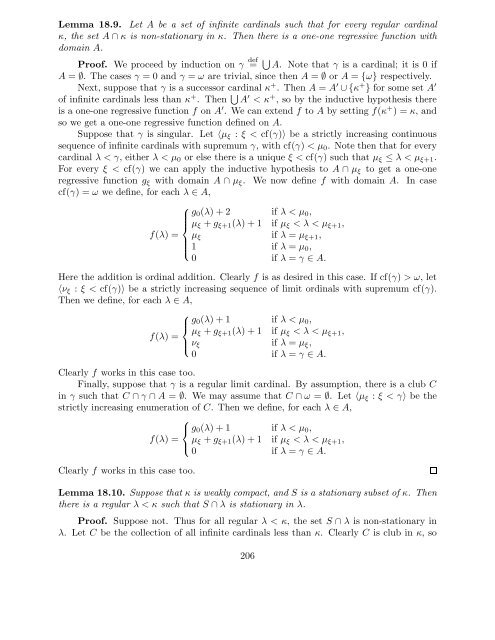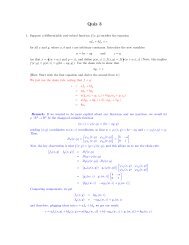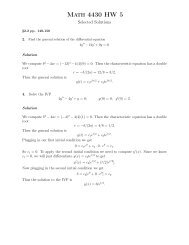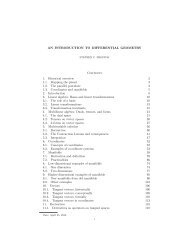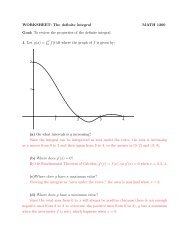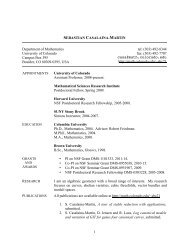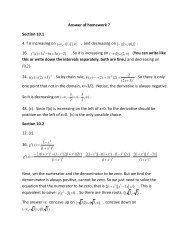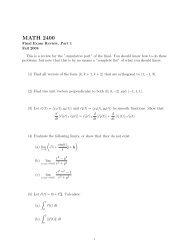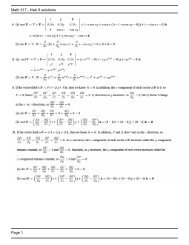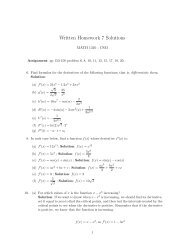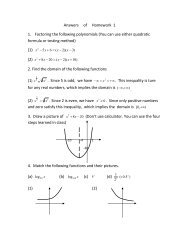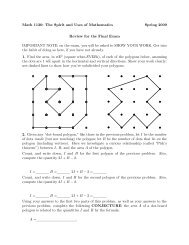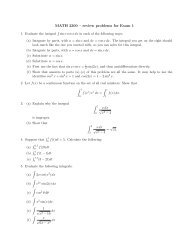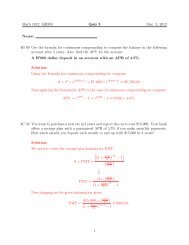18. Large cardinals
18. Large cardinals
18. Large cardinals
You also want an ePaper? Increase the reach of your titles
YUMPU automatically turns print PDFs into web optimized ePapers that Google loves.
Lemma <strong>18.</strong>9. Let A be a set of infinite <strong>cardinals</strong> such that for every regular cardinal<br />
κ, the set A ∩ κ is non-stationary in κ. Then there is a one-one regressive function with<br />
domain A.<br />
Proof. We proceed by induction on γ def<br />
= ⋃ A. Note that γ is a cardinal; it is 0 if<br />
A = ∅. The cases γ = 0 and γ = ω are trivial, since then A = ∅ or A = {ω} respectively.<br />
Next, suppose that γ is a successor cardinal κ + . Then A = A ′ ∪ {κ + } for some set A ′<br />
of infinite <strong>cardinals</strong> less than κ + . Then ⋃ A ′ < κ + , so by the inductive hypothesis there<br />
is a one-one regressive function f on A ′ . We can extend f to A by setting f(κ + ) = κ, and<br />
so we get a one-one regressive function defined on A.<br />
Suppose that γ is singular. Let 〈µ ξ : ξ < cf(γ)〉 be a strictly increasing continuous<br />
sequence of infinite <strong>cardinals</strong> with supremum γ, with cf(γ) < µ 0 . Note then that for every<br />
cardinal λ < γ, either λ < µ 0 or else there is a unique ξ < cf(γ) such that µ ξ ≤ λ < µ ξ+1 .<br />
For every ξ < cf(γ) we can apply the inductive hypothesis to A ∩ µ ξ to get a one-one<br />
regressive function g ξ with domain A ∩ µ ξ . We now define f with domain A. In case<br />
cf(γ) = ω we define, for each λ ∈ A,<br />
⎧<br />
g 0 (λ) + 2 if λ < µ 0 ,<br />
⎪⎨ µ ξ + g ξ+1 (λ) + 1 if µ ξ < λ < µ ξ+1 ,<br />
f(λ) = µ ξ if λ = µ ξ+1 ,<br />
⎪⎩ 1 if λ = µ 0 ,<br />
0 if λ = γ ∈ A.<br />
Here the addition is ordinal addition. Clearly f is as desired in this case. If cf(γ) > ω, let<br />
〈ν ξ : ξ < cf(γ)〉 be a strictly increasing sequence of limit ordinals with supremum cf(γ).<br />
Then we define, for each λ ∈ A,<br />
⎧<br />
g ⎪⎨ 0 (λ) + 1 if λ < µ 0 ,<br />
µ<br />
f(λ) = ξ + g ξ+1 (λ) + 1 if µ ξ < λ < µ ξ+1 ,<br />
⎪⎩ ν ξ if λ = µ ξ ,<br />
0 if λ = γ ∈ A.<br />
Clearly f works in this case too.<br />
Finally, suppose that γ is a regular limit cardinal. By assumption, there is a club C<br />
in γ such that C ∩ γ ∩ A = ∅. We may assume that C ∩ ω = ∅. Let 〈µ ξ : ξ < γ〉 be the<br />
strictly increasing enumeration of C. Then we define, for each λ ∈ A,<br />
⎧<br />
⎨g 0 (λ) + 1 if λ < µ 0 ,<br />
f(λ) = µ<br />
⎩ ξ + g ξ+1 (λ) + 1 if µ ξ < λ < µ ξ+1 ,<br />
0 if λ = γ ∈ A.<br />
Clearly f works in this case too.<br />
Lemma <strong>18.</strong>10. Suppose that κ is weakly compact, and S is a stationary subset of κ. Then<br />
there is a regular λ < κ such that S ∩ λ is stationary in λ.<br />
Proof. Suppose not. Thus for all regular λ < κ, the set S ∩ λ is non-stationary in<br />
λ. Let C be the collection of all infinite <strong>cardinals</strong> less than κ. Clearly C is club in κ, so<br />
206


